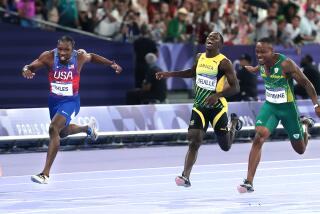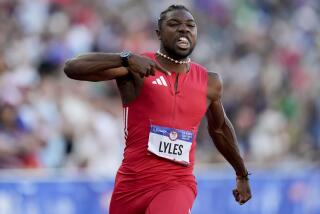TIMING IS EVERYTHING
- Share via
As athletic performances evolve, so does the technology for recording finish times. Photo cells and video cameras now break times down to the thousandth of a second. Photo finishes are instantly available not only to judges, but to the spectators and to the media. Here is how a few of the most innovative systems work:
Starter’s gun
Electronic gun signals start and activates race’s timing system.
Video backup
Camera records flame as it exits gun, allowing the exact time of the start to be verified.
Starter’s headset
If an athlete leaves early, judge is alerted through headset and fires again, nullifying race.
Starting blocks
Pressure-sensitive starting blocks help determine if an athlete starts too early.
Judges view this type of computer image to determine winners.
U.S. OLYMPIC TRIALS-100 METER MEN’S FINAL
The readout:
Clicking on the mouse produces a digital readout of the times in the race. Wind speed and reaction times are also shown.
Acceleration measurement
An electronic eye located behind the starting line is trained on the sprinter’s number, measuring speed and acceleration throughout the race.
Reaction times
Sprinters cannot leave the blocks in less than one-tenth of a second after gun is fired, the shortest amount of time the human nervous system can react. If an athlete leaves sooner, he or she has jumped the gun and the start is voided. Only one false start is allowed.
Determining winners
Electronic cameras scan the race and feed the information into a computer. A judge at a computer can then move an electronic cursor line to the correct position on the athletes as he or she crosses the finish line (the torso is all that matters at the finish: heads, arms, legs and feet don’t count).
NEW GADGETS
Electronic timing gear
80 computers
7,000 work stations
100 tons of equipment
Marathoner positions:
Transponders are attached to marathon runners’ shoes. Antennas placed along the course read the transponder much like a scanner at a grocery store. This makes it possible to see where an athlete is on the course.
Basketball hang times:
High-speed video cameras record when a basketball players leaves the floor and lands. A good hang time is about 1.5 seconds. Exact distances of shots also are measured.
Swimmers’ starts:
The delay between the starting signal and the moment the competitor’s feet leave the blocks is measured. During relays, “take-over” times are measured, the time between when a partner touches the wall and the next swimmer leaves.
Sources: Swatch, Atlanta Committee for the Olympic Games
More to Read
Go beyond the scoreboard
Get the latest on L.A.'s teams in the daily Sports Report newsletter.
You may occasionally receive promotional content from the Los Angeles Times.






